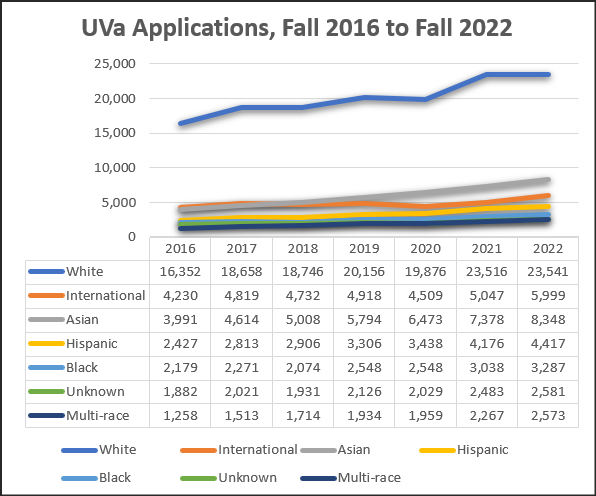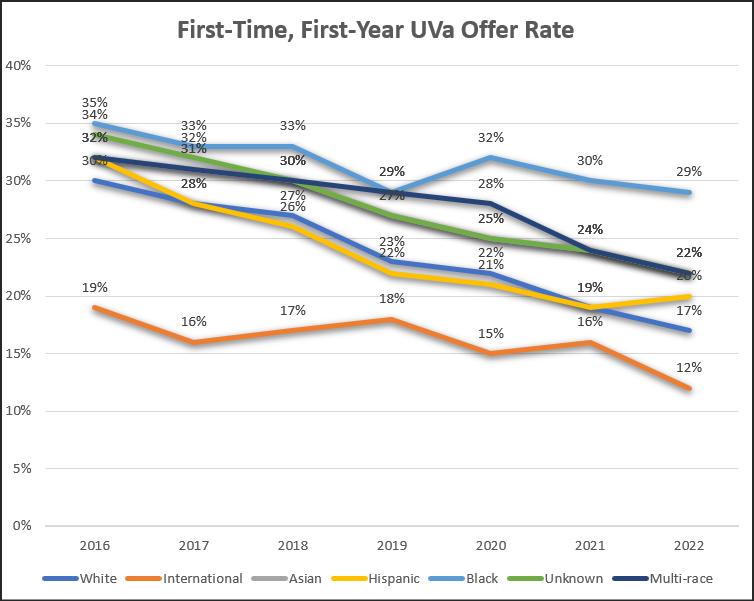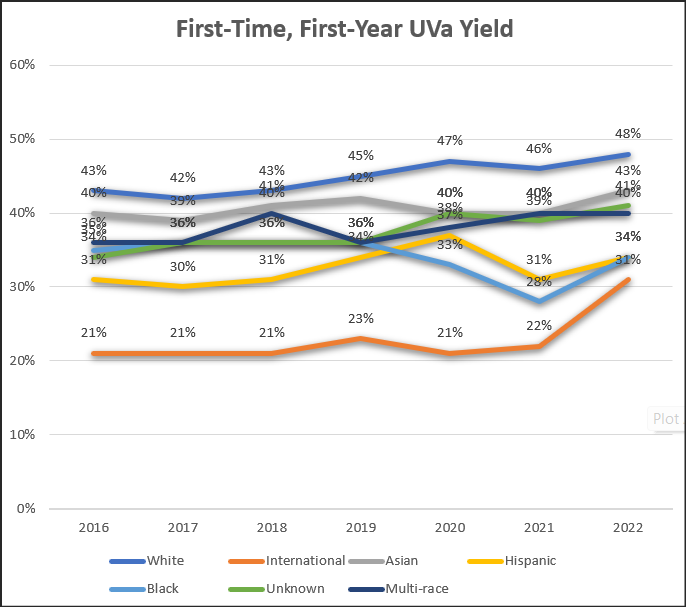
by James A. Bacon
As the University of Virginia community debates the implications of the U.S. Supreme Court ruling restricting the use of race in higher-ed admissions, The Jefferson Council is publishing publicly available data that provide context for the discussion.
UVa’s office of Institutional Research and Analysis publishes three types of admissions data (applications, admissions, and yield) broken down by race/ethnicity back to the 2016-17 academic year. Three trends stand out:
- Once a dominant majority of UVa students, Whites officially became a minority (47%) of the entering 1st-year student body in 2023;
- Asians were the fastest-growing racial/ethnic group at UVa, applying in greater numbers, being accepted in higher percentages, and (other than Whites) accepting those offers in higher percentages;
- Despite applying and being accepted in growing numbers, the percentage of Blacks accepting their offers actually declined slightly, in contrast to the other racial/ethnic groups.
Now for the details…
Applications (see graph above). Reflecting the national trend of surging applications to elite universities, applications to UVa increased between 2016-17 and 2022-23 school years among all racial/ethnic groups. Applications rose the most among Asian students (109%) and Hispanics (82%) and least among Blacks (51%) and Whites (44%).

Admissions. As applications rose, UVa became more selective. Admissions offers plunged 20.8% for Whites, the largest group, but rose for minority groups: Asians (43.1%), Blacks (29.1%), and Hispanics (15.9%).

Yield. As UVa became more selective, the percentage of students accepting UVa’s offer by enrolling (yield), increased for Asians by 13 percentage points, Whites by 5 percentage points, and Hispanics by 3 percentage points. The yield for Blacks declined by 1 percentage point.
Commentary. It comes as no surprise that the smallest increase in applications occurred among Whites. UVa has been recruiting minority students aggressively in a conscious effort to create a more diverse student body. Asian students appeared to take full advantage of the new emphasis.
The curiosity is the behavior of Black students. Despite unprecedented outreach by the university, Blacks lagged far behind Asians and Hispanics in the percentage increase in applications. And despite an offer rate that far exceeded that of any other group, the percentage of Blacks actually taking up UVa on its offer of admittance remained flat, actually declining slightly.
A question naturally follows: why, despite the aggressive outreach and high percentage of offers, are Blacks responding so sluggishly?
Two possibilities present themselves.
One is that every higher-ed institution wants to recruit more Blacks, none more so than the elite universities with whom UVa competes for the best and brightest students. UVa did manage to increase the number of 1st-year enrollees by 59 students over the six-year period, but it took considerable exertions to do so.
The other is that UVa has effectively branded itself, especially among Blacks, as a racist university — founded by a racist slaveholder, built by slaves, complicit in Jim Crow segregation, and a supporter of eugenics. The narratives that UVa tells about itself — especially by the Student Guides who provide many prospective students their first exposure to the university — dwell upon past injustices and slight the sweeping changes that have occurred there in the past 60 years. Concomitant with the reinterpretation of UVa’s past is the current rhetoric concerning systemic racism, White privilege, microaggressions and the like, which has coincided with a decline in the Black sense of “belonging.” Why would Black high school graduates want to attend a racist institution where Black students feel isolated, alienated and set upon?
The critical data missing from the Institutional Research and Analysis are SAT and ACT data, key measures of academic aptitude and preparation. The university refuses to release that data, likely because doing so would lay bare the drastically different standards for admitting Asians, Whites, Hispanics and Blacks. The data would illuminate the extent to which UVa admissions now are driven by “anti-racism” — the only antidote to past discrimination is present discrimination. But confession to dual standards would prove an embarrassment so we likely will never see it until a higher political authority compels the data’s release.
Meanwhile, if UVa wants to recruit more Black students, it should seriously consider the possibility that prevalent “anti-racist” rhetoric and the relentless focus on the university’s racist past might be counterproductive. But that would mean abandoning cherished progressive shibboleths… which means it likely will never happen.


